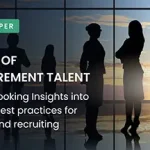Predicting the precise makeup of the procurement workforce in 2030 poses a challenge due to the intricate interplay of economic, technological, social, and regulatory factors.
In the first, second, and third installments of the Future of Procurement Talent series, we explored leading strategies for recruiting top talent, developing your internal teams, and retaining top procurement talent.
Attracting top procurement and supply chain talent in an evolving landscape
By 2030, recruitment is expected to heavily leverage technology, utilizing AI and data analytics to match candidates with job roles based on skills, cultural fit, and career aspirations.1 This approach aims to create more personalized and efficient recruitment experiences. AI’s role extends to optimizing resource allocation through the analysis of historical data and demand patterns. Candidate experiences will be highly personalized, with AI tailoring job recommendations, interview processes, and onboarding materials to align with individual preferences and skills.
Automation in talent acquisition
92%
of Talent executives
To bridge the skill gaps caused by the rapid growth of AI, talent acquisition leaders must explore the potential of AI-powered tools to automate their internal processes. These innovations can streamline various aspects of the recruitment journey, such as resume screening and interview scheduling.3
AI-powered technology enables the sourcing, screening, sorting, and ranking of candidates, creating a pool of qualified talent with the necessary skills for high-priority roles. Talent acquisition leaders can then compare these potential hires with internal candidates identified through their talent marketplace, a platform that leverages AI to match employees with suitable opportunities based on their skills and career aspirations.
Data-driven HR
80%
of Talent leaders
Data-driven HR strategies in procurement can optimize workforce management, align talent with business needs, and improve performance. By analyzing employee data, HR teams can identify areas for improvement and offer targeted training. Data analytics also inform recruitment decisions, sourcing channels, and candidate fit. This approach enhances retention with personalized development plans and career paths.
Predictive analytics is also prepped to be a strong tool, as it can analyze historical data to predict future trends, such as talent demand across different markets and industries.
Employer branding
The future of employer branding will find its foundation in purpose, values, and tech-driven experiences. Job seekers will be drawn to organizations aligning with their values, emphasizing meaningful work and holistic well-being. Transparent, empathetic, and collaborative leadership styles will define employer branding. The incorporation of virtual reality (VR) and augmented reality (AR) experiences may become commonplace, offering candidates immersive glimpses into a company’s culture, environment, and projects.
Remote work and global teams
By 2025, 32.6 million Americans will work remote by 2025. More so, the sentiment is that 57% of workers would look for a new job if their current company did not allow remote work, and 98% of workers want to work remote at least some of the time.5 With the growth of remote work, talent pools have become globally dispersed, encouraging the need for procurement talent leaders in the global workforce planning model. As remote work continues to be prevalent; organizations will emphasize their approach to a remote and hybrid approach, highlighting flexibility and work-life balance. Companies will focus on creating engaging remote onboarding experiences that seamlessly integrate new employees into the company culture and allow them to feel connected to their colleagues.
Diversity and inclusion
Diversity and inclusion initiatives will take a significant role, fostering a more diverse and inclusive workforce. The rise of remote work has paved the way to global inclusion. Procurement teams will feature diverse professionals from various geographical locations, promoting cross-cultural perspectives, and expanding market reach. Talent leaders can help foster collaboration in a diverse workplace and encourage diverse perspectives, to help with innovation and decision making, by promoting virtual team-building activities or internal organizational groups. As AI continues to rise, DEI will play a crucial role in mitigating biases in algorithms.
Although there are several ways in which AI can be used to improve workplace diversity through performance management processes, bias detection in discrimination and content, AI applications need to be carefully monitored and tested for fairness, risk mitigation and the ability to exacerbate biases. Procurement leaders will need to be mindful to not let the ease of using AI, override the human element of talent related decision making.6
Gig economy integration
Organizations will leverage freelance experts for specialized projects, providing flexibility and cost-effectiveness. Embrace the gig economy by hiring expert consultants or freelancers for specialized tasks: This provides flexibility and cost savings as these workers are paid per task, without the additional benefits associated with full-time employees.7
Employee development and retention
Looking ahead to 2030, procurement will see considerable influence from advanced technologies such as AI, machine learning, and automation. Procurement professionals will need to be adept at utilizing data analytics tools to make informed decisions, predict market trends, and optimize supplier relationships. The integration of AI and technology into procurement processes will have significant implications on procurement staffing, role structure, skill requirements, and overall efficiency.8 Additionally, the inclusion of comprehensive continued learning programs and employee resource will be a key factor behind an employer’s ability to retain top procurement talent.9 71% of employees say job training increased satisfaction, and 61% listed upskilling as a motivation to keep employment.10
The procurement role is constantly evolving due to both skill requirements stemming from the shifting technology landscape, as well as the shifting priorities of the CPO. 98% of procurement decision leaders said they are planning investments in AI, analytics and insights tools, and automation for their procurement function over the next couple of years.11 Additionally, the rise of automated tasks will reduce the need for manual work, freeing up labor needed for routine, manual tasks.
As the role of technology continues to transform procurement and supply chain, Procurement professionals will require a blend of technical and soft skills, including data analysis, AI utilization, negotiation, emotional intelligence, and cross-functional collaboration. Staff with data interpretation and analysis skills will be in high demand, creating new roles such as AI procurement analysts, digital procurement specialists, and technology integration managers.
As the CPO role continues to evolve against the background of a challenging procurement environment, their expanding influence on the top priorities will also play a key role in the required skill sets needed within the procurement organization.
The ProcureAbility-sponsored Annual 2024 ProcureCon CPO Report established that the top three focus areas for the CPOs in the next 12 months include process improvements, technology implementation and transformation as well as supply chain disruption.12 Expanding on AI initiatives and Delivering on ESG and sustainability goals were also key focus areas. These new priorities will determine what skillsets procurements talent leaders will look for, thus influencing the focal areas of procurement practitioners continued education.
Procurement continues to go through a transformative evolution as it delivers greater value for the organization and earns a strategic seat at the table. Procurement’s role will shift from transactional to strategic, actively contributing to business strategy and driving innovation within the supply chain.13
As the importance of supplier collaboration grows, procurement professionals will excel in managing strategic supplier relationships, co-innovating, and ensuring sustainable practices across the supply chain.
With growing emphasis on sustainability and ethical sourcing, procurement teams will play a vital role in ensuring responsible procurement practices, minimizing environmental impact, and adhering to social responsibility standards. Companies that demonstrate a strong commitment to sustainability, diversity, and community engagement will attract and retain top talent.
Procurement professionals will play a crucial role in ensuring robust data privacy and security measures, especially with the increasing use of digital platforms and data-driven decision-making.
44%
of executives report
That places the onus for (at least part of) data security efforts squarely on the Chief Procurement Officer. Due to this emerging need, new roles will emerge; some businesses may appoint cybersecurity category leads with duties spanning information technology and procurement. Additionally, new training requirements will be necessary to meet the need for cyber security-related category expertise.
The future of procurement staffing and recruiting in 2030 will be shaped by technological advancements, strategic priorities, and evolving workforce dynamics. Adaptability, continuous learning, and a proactive approach to change will be crucial for both professionals and organizations to thrive in this evolving landscape. Partnering with a third-party service provider can help you navigate the complexities of an ever-shifting talent market to drive your organization’s growth into 2030 and beyond.
Author:
Sources:
1 Future of Procurement Talent: Attracting Top Procurement Talent
2 Procurement Metrics that Matter in 2022
3 Human Resources and Recruitment Trends for 2024
4 Predictions on How Recruiting Will be Different in 2025
5 Remote Work Statistics and Trends in 2024
6 AI Brings Opportunities and Risks to Workplace DEI Efforts
7 5 Bold Predictions Whitepaper
8 Procurement Talent of the Future: Developing your procurement team from the inside out
9 Procurement Talent of the Future: Retaining Top Procurement Talent
10 The American Upskilling Study: Empowering Workers for the Jobs of Tomorrow
11 2024 State of Procurement Report
12 The 2024 Annual ProcureCon CPO Report
13 Moving your Procurement Organization from Tactical to Strategic





